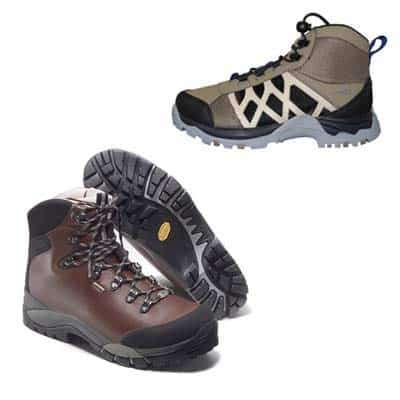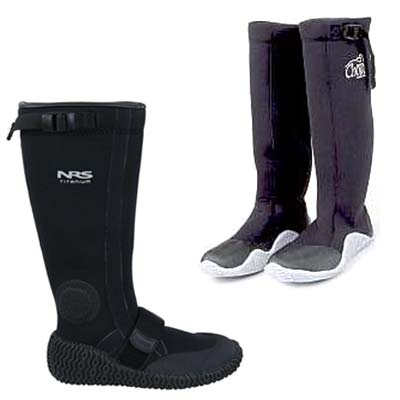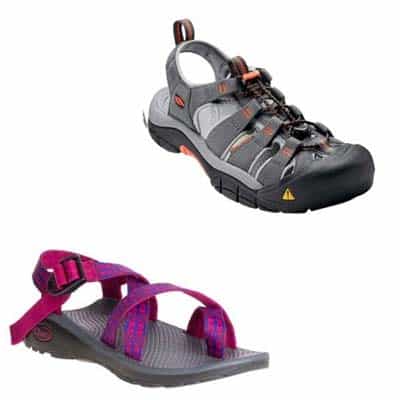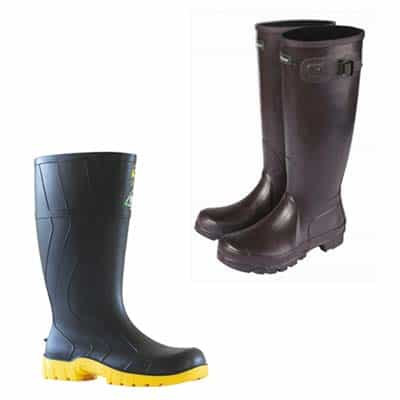Footwear for Canoeing: Finding Your Sole-Mate
by Gear Guide Rob Kesselring
I remember a great article by Cliff Jacobson several years ago in the Minnesota Canoe Association’s newsletter Hut about how BWCAW campers could best keep bears out of their grub pack. It was a little revolutionary and it led to a spirited stream of letters and opinions. I would guess there are at least as many opinions about the perfect canoeing shoe as there are about strategies to thwart bears from dipping into your peanut butter. Contemplating footwear may not be as exciting as planning a bear defense, but your feet are far more likely to give you a problem on a canoe trip than a bear is. Unhappy feet make for an unhappy canoeist. I hope this article leads to some posts from trip savvy Canoeing.com participants, because it is as much a request for help as a treatise on what works and doesn’t work when it comes to water, canoes, portage trails and feet.
“Sole mate” is a pun but not by much. Canoe campers ask a lot of their feet and finding the perfect sole-mate is no simple quest. Just imagine how challenging it would be to meet all the expectations in the personal ad below:
Wanted: Footwear for canoe camping. Must be able to support their partner carrying a heavy pack over rough terrain, must be able to withstand insults from water, oozing mud and slime-covered rocks, must be flexible enough for kneeling canoeists to tuck you under the seat, must be friendly on frosty mornings and dog day afternoons – must be joyful companions during long walks on the beach.
Believe me, I’ve done a lot of seeking, and all I have to show for it is a long string of casual encounters, but no life time, all-purpose partner for my feet. I do have 39 pairs of shoes in my closet. That does not exactly put me in Imelda Marcos’ category but you must admit I am invested It wasn’t always this way. When my feet were young, any old shoe would do. I did a 1,600-mile canoe trip in canvas sneakers without a blister or a slip, at least none that I remember. But times have changed and a three-year bout with Plantar Fasciitis made me especially sensitive. That malady may have been hastened by years of foot neglect. So, whether you are young and tough or wise and tender a focus on feet is in order.
The aboriginal people of far northern Canada, the Dene Indians, wear natural-tanned moose hide moccasins and slip-on rubbers. These are light, cheap (for them), pliable, and you touch the earth with every step. For paddling and moving about in the canoe there is nothing better. The rubbers provide some protection from dampness and the moose hide remains flexible even after repeated soakings. Being in two-parts speeds drying and enables the canoeist to just wear the moccasins around a dry camp and in the tent. On the downside, moose hide and rubber provide little cushioning between your feet and Mother Earth. When you are hauling a stuffed Duluth pack or anything made out of Royalex® you will feel every pebble. Also, the gumbo on places like Bottle Portage will suck off those mocs and leave you shoeless in short order. And not everyone has access to native-tanned moose hide. Water socks that were popular about ten years ago are the high-tech equivalent of moccasins, Before Plantar Fasciitis it made sense to carry them as my back-up shoes. For tough footed paddlers it still does. But on a canoe trip where even a modicum of portaging is involved, you may want more protection and support than moccasins or water socks can provide.
 At the other end of the spectrum are leather boots. Without question, dry leather boots provide the best support and protection on the portage trail. On the downside they can be uncomfortably warm in mid-summer, impossible to wear kneeling in the canoe, and difficult to keep dry. If you sit, have weak ankles and own an aluminum canoe, boots might work for you, but at least wear cooler, quicker drying GORE-TEX® models. You still sometimes see duck boots in the BWCAW. These are a hybrid of rubber bottoms and leather uppers popularized almost a century ago by LL Bean. Not everything old is bad and not everything new is good but the time for duck boots is over. They have no advantage over lighter, breathable GORE-TEX boots. If you still own a pair of duck boots, consider a divorce.
At the other end of the spectrum are leather boots. Without question, dry leather boots provide the best support and protection on the portage trail. On the downside they can be uncomfortably warm in mid-summer, impossible to wear kneeling in the canoe, and difficult to keep dry. If you sit, have weak ankles and own an aluminum canoe, boots might work for you, but at least wear cooler, quicker drying GORE-TEX® models. You still sometimes see duck boots in the BWCAW. These are a hybrid of rubber bottoms and leather uppers popularized almost a century ago by LL Bean. Not everything old is bad and not everything new is good but the time for duck boots is over. They have no advantage over lighter, breathable GORE-TEX boots. If you still own a pair of duck boots, consider a divorce.
Another option is neoprene booties. These vary in stoutness from little more than water socks to boot-like support with rugged hiking soles. Neoprene booties are “wet shoes” designed to be relatively comfortable and warm even when soaking wet. They are great for wading, lining, and tracking, okay for portaging and all but the most macho are flexible enough for comfortable kneeling. But love affairs with neoprene booties are short lived. Feet that are kept moistened for prolonged periods of time develop jungle rot in hot weather and trench foot in colder climes. Either malady will get your notice and can set-in after as little as four or five days. Even if you don’t contract these potentially trip-ending maladies, feet kept in wet neoprene soften.  I remember a trip on the Clarke River in the Northwest Territories where after a few days in booties we changed into trail shoes for a two-hour esker hike. I had worn these trail shoes for months without problems but after a couple days in the neoprene boots, my feet had softened to the point that just a short hike created a half dozen nasty blisters. Combining neoprene boots with breathable high waterproof socks, such as Sealskinz, can enable you to avoid some of these problems but Sealskinz are expensive and you no longer can be quite so gonzo wading deeply without swamping the socks and thereby being susceptible again to jungle rot. For short trips or occasional use neoprene booties are great, but in a long-term relationship they can be trying and odoriferous.
I remember a trip on the Clarke River in the Northwest Territories where after a few days in booties we changed into trail shoes for a two-hour esker hike. I had worn these trail shoes for months without problems but after a couple days in the neoprene boots, my feet had softened to the point that just a short hike created a half dozen nasty blisters. Combining neoprene boots with breathable high waterproof socks, such as Sealskinz, can enable you to avoid some of these problems but Sealskinz are expensive and you no longer can be quite so gonzo wading deeply without swamping the socks and thereby being susceptible again to jungle rot. For short trips or occasional use neoprene booties are great, but in a long-term relationship they can be trying and odoriferous.
Waterproof neoprene insulated mukluks championed by Chota have overcome some of the problems of neoprene booties and are available in varying degrees of ankle support and foot protection. I have not worn Chotas but they may be an excellent compromise.
Sport sandals are the standard on western rafting trips and they make sense for many canoeists too. The best sandals for canoeing and portaging are the top-of-the-line models made by the best companies. Cheap flip-flops and sport sandal knock-offs will disappoint and can even be a danger under the yoke of a canoe. Chacos are built on very substantial foot beds and are available in a wide variety of sizes.  They are one of the few shoes that do not bother my Plantar Fasciitis. But they are not the perfect canoe shoes. Pebbles get between your foot and the foot bed, there is zero protection for your toes and even broken-in Chacos that you wear flawlessly for months in the city can raise blisters when wet and under a load. Keen sport sandals have a nice toe bumper but lack the supportive foot bed that distinguishes Chacos. Sport sandals that wrap around the big toe have greater lateral stability but lack the versatility of others that allow you to wear neoprene or wool socks for cold or insect protection. Sandals are not for everyone but don’t be too quick to dismiss them.
They are one of the few shoes that do not bother my Plantar Fasciitis. But they are not the perfect canoe shoes. Pebbles get between your foot and the foot bed, there is zero protection for your toes and even broken-in Chacos that you wear flawlessly for months in the city can raise blisters when wet and under a load. Keen sport sandals have a nice toe bumper but lack the supportive foot bed that distinguishes Chacos. Sport sandals that wrap around the big toe have greater lateral stability but lack the versatility of others that allow you to wear neoprene or wool socks for cold or insect protection. Sandals are not for everyone but don’t be too quick to dismiss them.
Canvas sneakers may not be sexy but they are an effective and economical solution for many. Old high-top sneakers have more ankle support than sandals, fewer pebbles under the foot issues and more protection. On cold days with sneakers you can loosen the laces and usually fit on a pair of neoprene socks increasing their versatility. They dry slower than sandals which almost necessitates bringing a second pair of shoes for around the campfire, whereas with sandals the ultralight canoeist can just pull on a pair of dry wool socks and slip their dogs back into the quick-drying sandals. Don’t confuse this recommendation for sneakers with leather or fancy running shoes, which, after prolonged submersions often become heavy, blister making, stinkbombs. Some companies are marketing wet shoes and wet ankle boots made with synthetic materials impervious to water and vented to avoid some of the problems already mentioned. These may merit a good look.
In the arctic many paddlers swear by some type of waterproof knee-high gumboot.  If they are of high quality they will work but they will give kneelers fits. For me they always end up being an inch too short and as a result by sundown end up no better than neoprene booties. They also look pretty dorky when worn in the BWCAW with shorts and a t-shirt. If you are wearing gumboots, Wellies, Edmonton Oxfords, whatever you want to call them, ask yourself: Will I want to be seen wearing these things? Think hard about jpegs and YouTube before you commit to this relationship. Even wearing a PFD I choose not to wear hip boots canoeing. In the event of a spill they can be buggers to swim with and on a long portage they will chafe the inner thigh. That is never good, but I have seen them out there.
If they are of high quality they will work but they will give kneelers fits. For me they always end up being an inch too short and as a result by sundown end up no better than neoprene booties. They also look pretty dorky when worn in the BWCAW with shorts and a t-shirt. If you are wearing gumboots, Wellies, Edmonton Oxfords, whatever you want to call them, ask yourself: Will I want to be seen wearing these things? Think hard about jpegs and YouTube before you commit to this relationship. Even wearing a PFD I choose not to wear hip boots canoeing. In the event of a spill they can be buggers to swim with and on a long portage they will chafe the inner thigh. That is never good, but I have seen them out there.
So there are many different options and no consensus opinion. Maybe the perfect sole mate is the one that works for you. It does seem as if the one common denominator of canoeing footwear is a bit of a smell. Whether you’re sporting neoprene, leather or canvas you can count on a major funk going on. And this leads to my most important recommendation: Keep the footwear out of the tent. Maybe if you put your shoes in the grub pack they will keep the bears away.
Let’s hear your take on the perfect canoe country footwear. Leave your comment below and maybe you will help us all discover that elusive sole-mate.
Check out the Advanced Paddler Books & Media section for more of Rob’s Kesselring’s books.











Decent article except for the part slagging Bean boots. I’ve been tripping in Bean boots for thirty years or so, mostly in Temagami, a very tough area for paddling and especially portageing. And my feet are happy feet! My 80 lb. canoe, loaded draws maybe 5-6” of water, and my boots are 10””. So my boots don’t get wet much. They dry quickly . They are light enough to swim in when things go awry. They have good grip. They can be re-soled, minimizing waste. They are natural materials, mostly. I disagree with the implication that bean boots have had their day. To quote Miss Moneypenny, “Sometimes the old ways are still the best”!